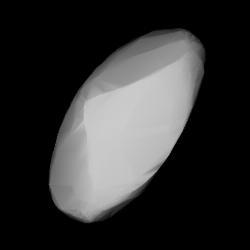2839 Annette
 Shape model of Annette from its lightcurve | |
| Discovery [1] | |
|---|---|
| Discovered by | C. W. Tombaugh |
| Discovery site | Lowell Obs. |
| Discovery date | 5 October 1929 |
| Designations | |
| (2839) Annette | |
Named after | Annette Tombaugh (discoverer's daughter)[2] |
| 1929 TP · 1937 AB1 1939 UL · 1962 TE 1970 BB · 1972 XF1 1982 VP | |
| main-belt · Flora [3] | |
| Orbital characteristics [1] | |
| Epoch 4 September 2017 (JD 2458000.5) | |
| Uncertainty parameter 0 | |
| Observation arc | 87.67 yr (32,023 days) |
| Aphelion | 2.5493 AU |
| Perihelion | 1.8838 AU |
| 2.2166 AU | |
| Eccentricity | 0.1501 |
| 3.30 yr (1,205 days) | |
| 200.55° | |
| 0° 17m 55.32s / day | |
| Inclination | 4.8085° |
| 44.569° | |
| 6.8264° | |
| Physical characteristics | |
Mean diameter | 5.41±0.86 km[4] 7.313±0.150 km[5] 7.562±0.122 km[6] |
| 10.457±0.003 h[7] 10.4595±0.0001 h[8] | |
| 0.0563±0.0118[6] 0.060±0.005[5] 0.24 (assumed)[3] 0.47±0.22[4] | |
| S [3] | |
| 12.9[1] · 12.92[4] · 14.35[3][6][8] | |
2839 Annette (prov. designation: 1929 TP) is a bright Flora asteroid from the inner regions of the asteroid belt. It was discovered on 5 October 1929, by American astronomer Clyde Tombaugh at Lowell Observatory during his search for Pluto.[9] The presumed S-type asteroid has a rotation period of 10.5 hours and measures approximately 5 kilometers (3.1 miles) in diameter. It was named after the discoverer's daughter.[2]
Orbit and classification[edit]
Annette is a S-type asteroid and member of the Flora family, one of the largest families of stony asteroids. It orbits the Sun in the inner main-belt at a distance of 1.9–2.5 AU once every 3 years and 4 months (1,205 days). Its orbit has an eccentricity of 0.15 and an inclination of 5° with respect to the ecliptic.[1] Due to a precovery taken at Lowell Observatory, the body's observation arc was extended by 4 days prior to its official discovery observation.[9]
Naming[edit]
This minor planet was named after Clyde Tombaugh's daughter, Annette.[2] The approved naming citation was published by the Minor Planet Center on 22 June 1986 (M.P.C. 10845).[10]
Physical characteristics[edit]
Rotation period[edit]

The first rotational lightcurve of Annette was obtained by American astronomer Brian Warner at his Palmer Divide Observatory, Colorado, in December 2005. It gave a rotation period of 10.457 hours with a brightness variation of 0.92 magnitude (U=3-).[7] In November 2006, a second lightcurve by astronomer Robert Buchheim at Altimira Observatory in southern California gave a concurring period of 10.4595 hours and an amplitude of 0.64 magnitude (U=3). He also noted a significantly fainter absolute magnitude of 14.35 than previously reported.[8]
Diameter and albedo[edit]
According to the survey carried out by NASA's Wide-field Infrared Survey Explorer with its subsequent NEOWISE mission, Annette measures between 5.41 and 7.562 kilometers in diameter and its surface has an albedo between 0.056 and 0.47,[4][5][6] while the Collaborative Asteroid Lightcurve Link assumes an albedo of 0.24 – derived from 8 Flora, the largest member and namesake of its family – and calculates a diameter of 3.66 kilometers using Robert Buchheim's fainter absolute magnitude of 14.35.[3]
References[edit]
- ^ a b c d "JPL Small-Body Database Browser: 2839 Annette (1929 TP)" (2017-06-02 last obs.). Jet Propulsion Laboratory. Retrieved 14 June 2017.
- ^ a b c Schmadel, Lutz D. (2007). "(2839) Annette". Dictionary of Minor Planet Names. Springer Berlin Heidelberg. p. 232. doi:10.1007/978-3-540-29925-7_2840. ISBN 978-3540002383.
- ^ a b c d e "LCDB Data for (2839) Annette". Asteroid Lightcurve Database (LCDB). Retrieved 9 March 2017.
- ^ a b c d Nugent, C. R.; Mainzer, A.; Bauer, J.; Cutri, R. M.; Kramer, E. A.; Grav, T.; et al. (September 2016). "NEOWISE Reactivation Mission Year Two: Asteroid Diameters and Albedos". The Astronomical Journal. 152 (3): 12. arXiv:1606.08923. Bibcode:2016AJ....152...63N. doi:10.3847/0004-6256/152/3/63.
- ^ a b c Masiero, Joseph R.; Grav, T.; Mainzer, A. K.; Nugent, C. R.; Bauer, J. M.; Stevenson, R.; et al. (August 2014). "Main-belt Asteroids with WISE/NEOWISE: Near-infrared Albedos". The Astrophysical Journal. 791 (2): 11. arXiv:1406.6645. Bibcode:2014ApJ...791..121M. doi:10.1088/0004-637X/791/2/121. S2CID 119293330. Retrieved 9 March 2017.
- ^ a b c d Mainzer, A.; Grav, T.; Masiero, J.; Hand, E.; Bauer, J.; Tholen, D.; et al. (November 2011). "NEOWISE Studies of Spectrophotometrically Classified Asteroids: Preliminary Results". The Astrophysical Journal. 741 (2): 25. arXiv:1109.6407. Bibcode:2011ApJ...741...90M. doi:10.1088/0004-637X/741/2/90. S2CID 35447010.
- ^ a b Warner, Brian D. (September 2006). "Asteroid lightcurve analysis at the Palmer Divide Observatory – late 2005 and early 2006" (PDF). Minor Planet Bulletin. 33 (3): 58–62. Bibcode:2006MPBu...33...58W. ISSN 1052-8091. Archived from the original (PDF) on 19 March 2020. Retrieved 18 March 2020.
- ^ a b c Buchheim, Robert K. (September 2007). "Lightcurves of 25 Phocaea, 468 Lina, 482 Petrina 551 Ortrud, 741 Botolphia, 834 Burnhamia, 2839 Annette, and 3411 Debetencourt" (PDF). Minor Planet Bulletin. 34 (3): 68–71. Bibcode:2007MPBu...34...68B. ISSN 1052-8091. Retrieved 18 March 2020.
- ^ a b "2839 Annette (1929 TP)". Minor Planet Center. Retrieved 9 March 2017.
- ^ "MPC/MPO/MPS Archive". Minor Planet Center. Retrieved 9 March 2017.
External links[edit]
- Lightcurve plot of 2839 Annette, Palmer Divide Observatory, B. D. Warner (2005)
- Lightcurve Database Query (LCDB), at www.minorplanet.info
- Dictionary of Minor Planet Names, Google books
- Asteroids and comets rotation curves, CdR – Geneva Observatory, Raoul Behrend
- Discovery Circumstances: Numbered Minor Planets (1)–(5000) – Minor Planet Center
- 2839 Annette at AstDyS-2, Asteroids—Dynamic Site
- 2839 Annette at the JPL Small-Body Database
